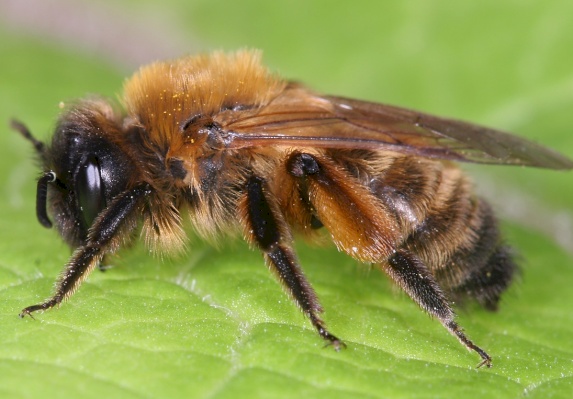Buffish mining bee
Picture Resource: Bees Wasps & Ants Recording Society, 2016. Andrena. Copyright: Ian Tew http://www.bwars.com/category/taxonomic-hierarchy/bee/andrenidae/andrena/andrena-nigroaenea , July 2016
Andrena nigroaenea is a solitary bee species commonly known as “buffish mining bee” because its yellowish-beige colour. West Palaearctic species, is widely distributed from Middle and West Europe (also United Kingdom), down to northernmost Africa, entire Mediterranean basin towards east in Palestine and wider area, Syria and Armenia. The North limit is Finland and Sweden, whilst the easternmost distribution of this species is Iran and Afghanistan. The buffish mining bee can often be seen in gardens of those warmer countries.
Andrena nigroaenea is about 13-15 mm long (males are 11-14mm long) with a quite plump body, dark gingery hairs on the thorax and abdomen. Females have black facial hairs and black hairs on the tip of the abdomen, whilst males have brown/red facial hairs. This species can easily be confounded with a honey bee, at first glance. However, the red-orange hair on their hind legs, forming the scopa, is a decisive characteristic to distinguish A. nigroaenea, since honey bees do not have scopa (instead, they have pollen plate).
Despite being a solitary species, digging its own nest hole and provisioning it with pollen and nectar as food resources for the development of its own eggs, the buffish mining bees can also be found nesting in communal agglomerations. In communal nests, several females may use the same nest entrance. However, into the nest, each female takes care of their own brood cells. Furthermore, this species can nest also in forests margins, grasslands, gardens, parks, steep walls and all kinds of soil. Andrena nigroaenea is polyletic, visiting several species of plants of different plant families, for feeding and for nesting resources. These bees are univoltine (one generation per year) and flies from April to July. Their nests are often parasitized by other bees that look like wasp, which are Nomada succincta, N. goodeniana and N. marshamella.
One very elegant behavioural characteristic of A. nigroaenea is the post-mating chemical compounds that female bees produce, inhibiting males mating behaviour. This odor communication facilitates the discrimination by males of receptive females from already mated individuals, hence an outcome of sexual selection.

